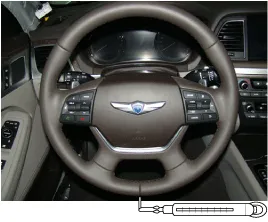Hyundai Genesis (DH): General Information / Repair procedures
| Service Adjustment Procedure |
| 1. |
Turn the steering wheel so that the front wheels are placed in the straight ahead position |
| 2. |
Measure the distance that the steering wheel is turned until the front wheels move.
|
| 3. |
If the play exceeds standard value, inspect the steering column, shaft, and linkages. |
| 1. |
Position the vehicle on level ground and place the steering wheel in the straight ahead position. |
| 2. |
Start the engine and turn the steering wheel from lock to lock several times to warm up the power steering fluid. |
| 3. |
Attach a spring scale to the steering wheel. With the engine
speed of 900 to 1100rpm, pull the scale and read it as soon as the
wheels begin to turn.
|
| 4. |
If the measured value exceeds standard value, inspect the power steering gear box and pump. |
Troubleshooting SymptomCause of the symptomRemedyExcessive play in steeringLoose U-joint boltRetighten or replace as necessaryLoose yoke plugRetightenLoose steering gear mounting boltsRetightenLoose or worn tie rod endRetighten or replace as necessarySteering wheel does not return to its original positionExcessive turning resistance of tie rod endReplaceYoke plug excessively tightAdjustTie rod and/or ball joint cannot turn smoothlyReplaceLoose mounting of gear box mounting bracket at the subframeRetightenWorn steering shaft joint and/or body grommetCorrect or replaceDistorted rackReplaceRattling or chucking noise in the rack and pinionLoose steering gear box mountingRepositionLoose tie rod end and/or ball jointRetightenWorn tie rod and/or ball jointRetightenLoose yoke plugReplace
Other information:
Hyundai Genesis (DH) 2013-2016 Service Manual: Components and Components Location
C
Hyundai Genesis (DH) 2013-2016 Service Manual: Compressor oil Repair procedures
Oil Specification 1. The HFC-134a system requires synthetic (PAG) compressor oil whereas the R-12 system requires mineral compressor oil. The two oils must never be mixed. 2. Compressor (PAG) oil varies according to compressor model. Be sure to use oil specified for the compressor model.
Categories
- Manuals Home
- Hyundai Genesis Owners Manual
- Hyundai Genesis Service Manual
- Suspension System
- Floor Carpet
- 27 Brake Control Solenoid Valve Schematic Diagrams
- New on site
- Most important about car


